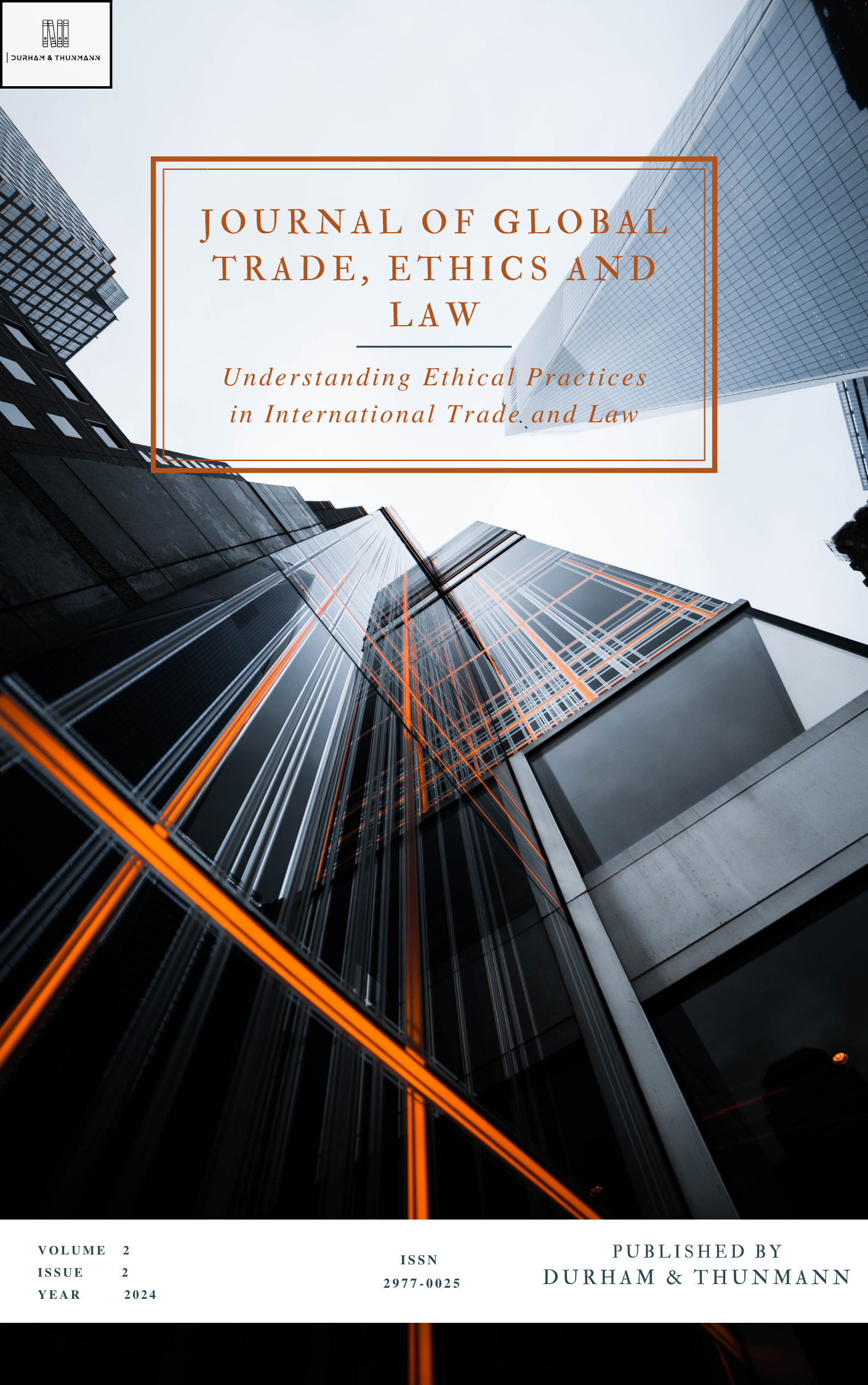
Published 2024-12-31
Keywords
- Russia,
- Ukraine,
- War,
- Economic Simulating,
- Economic Desgrowth
Copyright (c) 2024 Journal of Global Trade, Ethics and Law

This work is licensed under a Creative Commons Attribution 4.0 International License.
How to Cite
Abstract
This paper introduces a new economic simulator in the case of a war, this new economic simulator is entitled “The Post-War Economic Impact Simulator (PEI-Simulator).” The primary objective of the PEI-Simulator is to analyse wars at various stages to assess their overall socio-economic impact in both the short and long term. Additionally, it shifts away from the traditional benefit-cost analysis of war, introducing a new simulator that represents war scenarios from a more complex and dynamic perspective. The PEI-Simulator assesses the economic impacts of countries thorough the possible scenario of a partial or full war in three different stages: (i) pre-war stage; (ii) war stage; (iii) post-war stage. The analysis makes use of different indicators such as economic desgrowth from war (-δwar), war intensity (I), war losses (-Lwar), economic wear from war (Πwar), level of war tension (Twar), level of diplomatic negotiations (D), and the total economic leaking from war (Ωwar). Lastly, this research applies the PEI-Simulator to evaluate a possible full war between Russia and Ukraine.
Downloads
References
- Barro, Robert J., and Jong-Wha Lee. “Sources of Economic Growth.” Carnegie-Rochester Conference Series on Public Policy 40 (June 1994): 1–46. DOI: https://doi.org/10.1016/0167-2231(94)90002-7
- Bergsten, C. Fred. “The World Economy after the Cold War.” Foreign Affairs 69, no. 3 (1990): 96–112. https://doi.org/10.2307/20044403. DOI: https://doi.org/10.2307/20044403
- Bilmes, Linda. The Financial Legacy of Iraq and Afghanistan: How Wartime Spending Decisions Will Constrain Future National Security Budgets. HKS Working Paper No. RWP13-006, 2013. DOI: https://doi.org/10.2139/ssrn.2281275
- Blattman, Christopher, and Edward Miguel. “Civil War.” Journal of Economic Literature 48, no. 1 (2010): 3–57. http://www.jstor.org/stable/40651577. DOI: https://doi.org/10.1257/jel.48.1.3
- Boden, R. “Cold War Economics: Soviet Aid to Indonesia.” Journal of Cold War Studies 10, no. 3 (2008): 110–28. https://www.jstor.org/stable/26922777. DOI: https://doi.org/10.1162/jcws.2008.10.3.110
- Central Bank of Russia. Annual Statistics. 2024. http://www.cbr.ru/eng/ (accessed June 24, 2024).
- Central Bank of Ukraine. Annual Statistics. 2024. http://www.bank.gov.ua/control/en/ (accessed November 24, 2024).
- Collier, Paul. “On the Economic Consequences of Civil War.” Oxford Economic Papers 51, no. 1 (1999): 168–83. DOI: https://doi.org/10.1093/oep/51.1.168
- Gleick, James. Chaos: Making a New Science. New York: Penguin Books, 1988. DOI: https://doi.org/10.1063/1.2811320
- International Monetary Fund. Annual Report. 2024. http://www.imf.org (accessed January 1, 2024). DOI: https://doi.org/10.5089/9798400278204.002
- Koubi, Vally. “War and Economic Performance.” Journal of Peace Research 42, no. 1 (2005): 67–82. DOI: https://doi.org/10.1177/0022343305049667
- Lawrence, F. W. P. “War Economics.” The Economic Journal 25, no. 100 (1915): 512–20. DOI: https://doi.org/10.2307/2221590
- Lorenz, Edward. The Essence of Chaos. Washington: University of Washington Press, 1993. DOI: https://doi.org/10.4324/9780203214589
- Markusen, Ann. “Dismantling the Cold War Economy.” World Policy Journal 9, no. 3 (1992): 389–99. http://www.jstor.org/stable/40209258.
- Meduza. “Why Russia’s Economy Appears to Be Booming in the Face of Sanctions.” Accessed December 26, 2024. https://meduza.io.
- Ministry of Defense of Russia. General Statistics. 2024. http://eng.mil.ru/ (accessed January 24, 2024).
- Ministry of Defense of Ukraine. General Statistics. 2024. http://www.mil.gov.ua/en/ (accessed January 24, 2024).
- Ministry of Development and Trade of Ukraine. Statistics from 1999 to 2024. 2024. http://www.kmu.gov.ua/control/en/publish/article?art_id=88549 (accessed April 2024).
- Ministry of Economic Development and Trade of Russia. Statistics from 1999 to 2024. 2024. http://economy.gov.ru/wps/wcm/connect/economylib4/en/home/ (accessed April 2024).
- Ministry of Education and Science of Russia. Annual Statistics. 2024. http://government.ru/en/department/33/events/ (accessed March 30, 2024).
- Ministry of Finance of Russia. Finance Annual Report. 2024. http://government.ru/en/department/69/events/ (accessed April 2024).
- Ministry of Finance of Ukraine. Ukraine’s Recovery. 2024. http://mof.gov.ua/ (accessed January 2024).
- Ministry of Foreign Affairs of Russia. Annual Statistics. 2024. http://www.mid.ru/brp_4.nsf/main_eng (accessed March 27, 2024).
- Ministry of Foreign Affairs of Ukraine. Annual Statistics. 2024. http://mfa.gov.ua/en (accessed November 10, 2024).
- Murdoch, James C., and Todd Sandler. “Economic Growth, Civil Wars, and Spatial Effects.” Journal of Conflict Resolution 46, no. 1 (2002): 91–110. DOI: https://doi.org/10.1177/0022002702046001006
- Nagashima, Hiroshi, and Yoshiyuki Baba. Introduction to Chaos. Tokyo: Baifukan Co. Ltd., 1992.
- Organski, A. F. K., and Jacek Kugler. “The Costs of Major Wars: The Phoenix Factor.” American Political Science Review 71, no. 4 (1977): 1347–66. DOI: https://doi.org/10.1017/S0003055400269657
- Organski, A. F. K., and Jacek Kugler. The War Ledger. Chicago: University of Chicago Press, 1980. DOI: https://doi.org/10.7208/chicago/9780226351841.001.0001
- Pasvolsky, Leo. “Post War Economics.” World Affairs 105, no. 2 (1942): 87–95. http://www.jstor.org/stable/20663716.
- Rasler, Karen, and William Thompson. “War and the Economic Growth of Major Powers.” American Journal of Political Science 29, no. 3 (1985): 513–38. DOI: https://doi.org/10.2307/2111141
- Ruiz Estrada, Mario Arturo, and Siong-Fook Yap. “The Origins and Evolution of Policy Modeling.” Journal of Policy Modeling 35, no. 1 (2013): 170–82. DOI: https://doi.org/10.1016/j.jpolmod.2011.12.003
- Ruiz Estrada, Mario Arturo, Donghyun Park, and Geunwoo Kim. “An Economic Simulator of the Wartime Economy: An Application to a Possible Sino-Japanese Conflict.” Fudan Journal of the Humanities and Social Sciences 9, no. 1 (2015): 1–23. DOI: https://doi.org/10.1007/s40647-015-0114-7
- Ruiz Estrada, Mario Arturo, Siong-Fook Yap, and Donghyun Park. “The Natural Disasters Vulnerability Evaluation Simulator (NDVE-Simulator): An Application to the Northeast Japan Earthquake and Tsunami of March 2011.” Disasters 38 (2014): s206–s29. DOI: https://doi.org/10.1111/disa.12069
- Ruiz Estrada, Mario Arturo. “An Alternative Graphical Modeling for Economics: Econographicology.” Quality and Quantity 51, no. 5 (2017): 2115–39. DOI: https://doi.org/10.1007/s11135-015-0280-3
- Ruiz Estrada, Mario Arturo. “Policy Modeling: Definition, Classification, and Evaluation.” Journal of Policy Modeling 33, no. 4 (2011): 523–36. DOI: https://doi.org/10.1016/j.jpolmod.2011.02.003
- Smith, Ron P. “The Economic Costs of Military Conflict.” Journal of Peace Research 51, no. 2 (2014): 245–56. DOI: https://doi.org/10.1177/0022343313496595
- TASS. “World Bank Improves Forecast for Russian GDP Growth in 2024–2025.” Accessed December 26, 2024. https://tass.com.
- The Moscow Times. “IMF Raises Russia’s Growth Forecast for 2024.” Accessed December 26, 2024. https://themoscowtimes.com.
- Wheeler, Howard. “Postwar Industrial Growth.” In The Correlates of War II: Testing Some Real Political Simulators, edited by J. David Singer, 217–38. New York: Free Press, 1980.
- World Bank. Annual Report. 2024. http://www.wb.org (accessed November 18, 2024).
